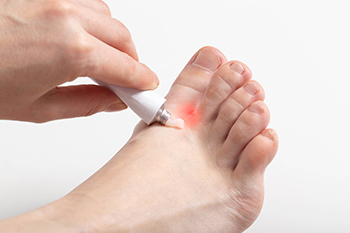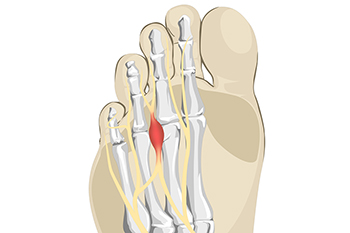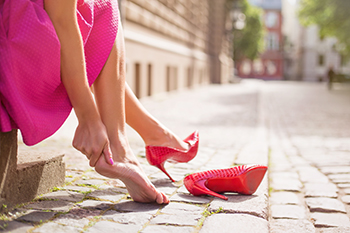Connect With Us
Blog
Items filtered by date: November 2022
Athlete's Foot or Dry Skin?

Anyone who is conscious about maintaining the health of their feet ought to be familiar with the important differences between mere dry skin on the feet and a case of athlete’s foot. The former condition does not always imply the existence of the latter. For example, if you have dry skin on your feet, you might notice a rough texture and even itching sensations. Sometimes dry skin is accompanied by cracked heels, also known as heel fissures. Athlete’s foot, on the other hand, is a kind of fungal infection that creates a red rash. Athlete’s foot can be contracted by walking around barefoot in highly trafficked public places, like locker rooms. Importantly, it is possible to have both dry skin and athlete’s foot at the same time. For more information about the difference between athlete’s foot and dry skin, contact a podiatrist today. This foot specialist will be able to answer any questions you might have.
Athlete’s foot is an inconvenient condition that can be easily reduced with the proper treatment. If you have any concerns about your feet and ankles, contact David Mansky, DPM from Mansky Podiatry. Our doctor will treat your foot and ankle needs.
Athlete’s Foot: The Sole Story
Athlete's foot, also known as tinea pedis, can be an extremely contagious foot infection. It is commonly contracted in public changing areas and bathrooms, dormitory style living quarters, around locker rooms and public swimming pools, or anywhere your feet often come into contact with other people.
Solutions to Combat Athlete’s Foot
- Hydrate your feet by using lotion
- Exfoliate
- Buff off nails
- Use of anti-fungal products
- Examine your feet and visit your doctor if any suspicious blisters or cuts develop
Athlete’s foot can cause many irritating symptoms such as dry and flaking skin, itching, and redness. Some more severe symptoms can include bleeding and cracked skin, intense itching and burning, and even pain when walking. In the worst cases, Athlete’s foot can cause blistering as well. Speak to your podiatrist for a better understanding of the different causes of Athlete’s foot, as well as help in determining which treatment options are best for you.
If you have any questions please feel free to contact our office located in Hastings, MI . We offer the newest diagnostic and treatment technologies for all your foot and ankle needs.
All About Morton’s Neuroma

Morton’s neuroma is named for a doctor who discovered this condition in 1876. It affects the nerve that runs between the long bones of the foot, commonly the 3rd and 4th metatarsals. The main symptoms of Morton’s neuroma are pain and numbness in the toes above the affected metatarsals. It can produce the same symptoms in the nerve between the 2nd and 3rd metatarsals. Morton’s neuroma usually affects only one foot and rarely affects two nerves of the same foot. The exact cause of Morton’s neuroma is not clear, but it is thought to be the result of a thickening of the nerve. This effect may be produced by chronic compression of the nerves. About three-quarters of people with Morton’s neuroma are women between the ages of 40 and 50. It is believed that tight or poorly fitting shoes greatly contribute to the formation of Morton’s neuroma, and it is common among runners and ballet dancers. Symptoms include pain that starts in the ball of the foot and shoots into the nearby toes. There also may be burning and tingling, along with a feeling of having a small pebble in the shoe. For a diagnosis and treatment options for Morton’s neuroma, it is suggested that you visit a podiatrist.
Morton’s neuroma is a very uncomfortable condition to live with. If you think you have Morton’s neuroma, contact David Mansky, DPM of Mansky Podiatry. Our doctor will attend to all of your foot care needs and answer any of your related questions.
Morton’s Neuroma
Morton's neuroma is a painful foot condition that commonly affects the areas between the second and third or third and fourth toe, although other areas of the foot are also susceptible. Morton’s neuroma is caused by an inflamed nerve in the foot that is being squeezed and aggravated by surrounding bones.
What Increases the Chances of Having Morton’s Neuroma?
- Ill-fitting high heels or shoes that add pressure to the toe or foot
- Jogging, running or any sport that involves constant impact to the foot
- Flat feet, bunions, and any other foot deformities
Morton’s neuroma is a very treatable condition. Orthotics and shoe inserts can often be used to alleviate the pain on the forefront of the feet. In more severe cases, corticosteroids can also be prescribed. In order to figure out the best treatment for your neuroma, it’s recommended to seek the care of a podiatrist who can diagnose your condition and provide different treatment options.
If you have any questions, please feel free to contact our office located in Hastings, MI . We offer the newest diagnostic and treatment technologies for all your foot care needs.
Feet and Blood Sugar
 As anyone who takes their health seriously undoubtedly knows, the condition of your feet is central to maintaining a healthy, balanced lifestyle. There are many everyday foot care techniques that one may take to care of their feet. One example is by managing your blood sugar levels. When an individual has significantly high blood sugar levels, one’s blood vessels might be negatively impacted. As a result, the blood circulation to the feet can be diminished. This can lead to gangrene or peripheral vascular disease, among other things. Importantly, individuals who suffer from diabetes are very susceptible to experiencing high blood pressure. These individuals might consider being particularly diligent about managing their blood pressure. Consult a podiatrist today for more information.
As anyone who takes their health seriously undoubtedly knows, the condition of your feet is central to maintaining a healthy, balanced lifestyle. There are many everyday foot care techniques that one may take to care of their feet. One example is by managing your blood sugar levels. When an individual has significantly high blood sugar levels, one’s blood vessels might be negatively impacted. As a result, the blood circulation to the feet can be diminished. This can lead to gangrene or peripheral vascular disease, among other things. Importantly, individuals who suffer from diabetes are very susceptible to experiencing high blood pressure. These individuals might consider being particularly diligent about managing their blood pressure. Consult a podiatrist today for more information.
Diabetic foot care is important in preventing foot ailments such as ulcers. If you are suffering from diabetes or have any other concerns about your feet, contact David Mansky, DPM from Mansky Podiatry. Our doctor can provide the care you need to keep you pain-free and on your feet.
Diabetic Foot Care
Diabetes affects millions of people every year. The condition can damage blood vessels in many parts of the body, especially the feet. Because of this, taking care of your feet is essential if you have diabetes, and having a podiatrist help monitor your foot health is highly recommended.
The Importance of Caring for Your Feet
- Routinely inspect your feet for bruises or sores.
- Wear socks that fit your feet comfortably.
- Wear comfortable shoes that provide adequate support.
Patients with diabetes should have their doctor monitor their blood levels, as blood sugar levels play such a huge role in diabetic care. Monitoring these levels on a regular basis is highly advised.
It is always best to inform your healthcare professional of any concerns you may have regarding your feet, especially for diabetic patients. Early treatment and routine foot examinations are keys to maintaining proper health, especially because severe complications can arise if proper treatment is not applied.
If you have any questions please feel free to contact our office located in Hastings, MI . We offer the newest diagnostic and treatment technologies for all your foot and ankle needs.
Are You Suffering From Nerve Damage?
Fractures and High Heels

It is certainly no secret that wearing high heels is not healthy for the feet. In fact, it can put them at an increased risk of injury. Wearing high heels puts extreme pressure on the midfoot arch. If a person were to fall wearing high heels, they can cause a fracture in the bones in this area of the foot. When this happens, it is possible for the midfoot to break or dislocate in some way. Most often when a fracture of this nature develops, some individuals might not take it as seriously as they should. This kind of fracture can be quite uncomfortable and cause many complications. In this situation, it is best to contact a podiatrist who can examine your feet and provide you with the most helpful advice and treatment.
High heels have a history of causing foot and ankle problems. If you have any concerns about your feet or ankles, contact David Mansky, DPM from Mansky Podiatry. Our doctor can provide the care you need to keep you pain-free and on your feet.
Effects of High Heels on the Feet
High heels are popular shoes among women because of their many styles and societal appeal. Despite this, high heels can still cause many health problems if worn too frequently.
Which Parts of My Body Will Be Affected by High Heels?
- Ankle Joints
- Achilles Tendon – May shorten and stiffen with prolonged wear
- Balls of the Feet
- Knees – Heels cause the knees to bend constantly, creating stress on them
- Back – They decrease the spine’s ability to absorb shock, which may lead to back pain. The vertebrae of the lower back may compress.
What Kinds of Foot Problems Can Develop from Wearing High Heels?
- Corns
- Calluses
- Hammertoe
- Bunions
- Morton’s Neuroma
- Plantar Fasciitis
How Can I Still Wear High Heels and Maintain Foot Health?
If you want to wear high heeled shoes, make sure that you are not wearing them every day, as this will help prevent long term physical problems. Try wearing thicker heels as opposed to stilettos to distribute weight more evenly across the feet. Always make sure you are wearing the proper shoes for the right occasion, such as sneakers for exercising. If you walk to work, try carrying your heels with you and changing into them once you arrive at work. Adding inserts to your heels can help cushion your feet and absorb shock. Full foot inserts or metatarsal pads are available.
If you have any questions please feel free to contact our office located in Hastings, MI . We offer the newest diagnostic and treatment technologies for all your foot and ankle needs.
Possible Benefits of Walking Barefoot

There are several benefits that can occur when parents encourage their children to walk barefoot. These can include improvements in balance, walking, and range of motion. Additionally, the joints and muscles in the feet can become stronger, as a result of the toes gripping the floor. Research has indicated that the nervous system is stimulated when a child walks barefoot, and pressure points are used to send messages to various parts of the body. Children often become more aware of their surroundings when they walk barefoot outside. Walking on different surfaces such as grass, sand, leaves, and concrete can help the child to become more sensitive to nature. Their motor skills may be improved, and it may be easier to jump and balance during playtime activities. It is advised that sunscreen is applied to the child’s feet, and as a precaution against getting a sunburn, shoes may need to be worn outside on a particularly sunny day. If you would like more information about the benefits of having your child walk barefoot, please ask a podiatrist who can help you with the information you are seeking.
Making sure that your children maintain good foot health is very important as they grow. If you have any questions, contact David Mansky, DPM of Mansky Podiatry. Our doctor can provide the care you need to keep you pain-free and on your feet.
Keeping Children's Feet Healthy
Having healthy feet during childhood can help prevent medical problems later in life, namely in the back and legs. As children grow, their feet require different types of care. Here are some things to consider...
Although babies do not walk yet, it is still very important to take care of their feet.
Avoid putting tight shoes or socks on his or her feet.
Allow the baby to stretch and kick his or her feet to feel comfortable.
As a toddler, kids are now on the move and begin to develop differently. At this age, toddlers are getting a feel for walking, so don’t be alarmed if your toddler is unsteady or ‘walks funny’.
As your child gets older, it is important to teach them how to take care of their feet.
Show them proper hygiene to prevent infections such as fungus.
Be watchful for any pain or injury.
Have all injuries checked by a doctor as soon as possible.
Comfortable, protective shoes should always be worn, especially at play.
If you have any questions please feel free to contact our office located in Hastings, MI . We offer the newest diagnostic and treatment technologies for all your foot and ankle needs.
Blog Archives
- April 2025
- March 2025
- February 2025
- January 2025
- December 2024
- November 2024
- October 2024
- September 2024
- August 2024
- July 2024
- June 2024
- May 2024
- April 2024
- March 2024
- February 2024
- January 2024
- December 2023
- November 2023
- October 2023
- September 2023
- August 2023
- July 2023
- June 2023
- May 2023
- April 2023
- March 2023
- February 2023
- January 2023
- December 2022
- November 2022
- October 2022
- September 2022
- August 2022
- July 2022
- June 2022
- May 2022
- April 2022

